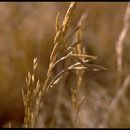en
names in breadcrumbs


A very useful fodder grass introduced into the British Ises and North America for this reason.
Bromus inermis is a species of the true grass family (Poaceae). This rhizomatous grass is native to Europe and considered invasive in North America.
The plant is characterized by an erect, leafy, long-lived perennial, 46 to 91 cm (1+1⁄2 to 3 ft) tall, rhizomatous and commonly producing a dense sod. It starts growth in early spring; flowers May to July; reproduces from seeds, tillers, and rhizomes. It may regrow and re flower in the fall if moisture is sufficient.[1] The leaves are glabrous or occasionally pubescent, particularly on the sheaths; blades 20 to 38 cm (8 to 15 in) long, 0.6 to 1.3 cm (1⁄4 to 1⁄2 in) wide, flat, with a raised and keeled midrib below; sheaths closed, except near collar, and papery when dry; leaves rolled in the bud; ligates up to 0.3 cm (1⁄8 in) long, rounded, and membranous; auricles absent.
Bromus inermis is a species of the true grass family (Poaceae). This rhizomatous grass is native to Europe and considered invasive in North America.
The plant is characterized by an erect, leafy, long-lived perennial, 46 to 91 cm (1+1⁄2 to 3 ft) tall, rhizomatous and commonly producing a dense sod. It starts growth in early spring; flowers May to July; reproduces from seeds, tillers, and rhizomes. It may regrow and re flower in the fall if moisture is sufficient. The leaves are glabrous or occasionally pubescent, particularly on the sheaths; blades 20 to 38 cm (8 to 15 in) long, 0.6 to 1.3 cm (1⁄4 to 1⁄2 in) wide, flat, with a raised and keeled midrib below; sheaths closed, except near collar, and papery when dry; leaves rolled in the bud; ligates up to 0.3 cm (1⁄8 in) long, rounded, and membranous; auricles absent.